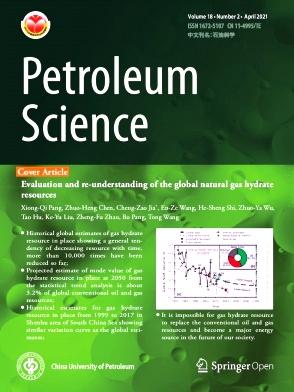高强度可固化树脂堵漏材料的固化动力学和堵漏机理
IF 6
1区 工程技术
Q2 ENERGY & FUELS
引用次数: 0
摘要
循环损失是钻井作业中经常出现的危险,会导致钻井液大量流失,并在渗入地层后造成严重后果。随着钻井深度的增加,地层温度和压力也随之升高,对堵塞材料提出了更高的要求。本研究采用溶液分步开环聚合法制备了一种具有致密交叉网状结构的可控固化树脂。本研究考察的树脂堵塞材料是一种连续相材料,具有注射方便、填充能力强、保持力优异、地下固化或交联强度高等特点。它的多功能性不受断裂-空洞失水通道的限制,因此在堵塞断裂-空洞碳酸盐岩时,可满足各种断裂-空洞组合的基本需求。值得注意的是,固化时间可在 3-7 小时的跨度内进行微调,以满足不同断裂尺寸的钻井液流失的堵塞需求。实验研究涵盖了树脂堵塞系统的流变特性和固化行为,揭示了固化过程的复杂性,并建立了可靠的动力学模型。实验结果表明,脲醛树脂堵塞材料具有紧密的链状或网状结构。当脲醛树脂堵塞系统溶液的浓度保持在 30% 以下时,粘度仅为 10 mPa-s。最佳固化温度为 60 °C,对盐碱环境的适应能力令人印象深刻。值得注意的是,当脲醛树脂浸泡在含有 50000 mg/L NaCl 和 100000 mg/L CaCl2 的复合盐水环境中时,会固化成更加紧凑的网络结构,最终达到 41.5 MPa 的出色抗压强度。通过解析非等温 DSC 固化反应参数的转化率与表观活化能之间的相关性,该研究证明了脲醛树脂堵塞体系动力学方程的正确性。这一辨证分析揭示了脲醛树脂堵塞体系微观反应机理的细微变化。此外,还研究了树脂堵塞系统对不同尺寸裂缝的承压堵塞能力。研究发现,在一定温度条件下,该树脂堵塞体系能有效驻留不同尺寸的平行和楔形裂缝,并形成高强度固结。出口尺寸为 3 mm 的平行裂缝树脂堵塞体系的最大堵塞压力可达 9.92 MPa,出口尺寸为 5 mm 的楔形裂缝树脂堵塞体系的最大堵塞压力可达 9.90 MPa。因此,脲醛树脂堵漏材料的探索和应用实现了模式的转变,为解决钻井液堵漏的实际问题提供了新的理念和方法。本文章由计算机程序翻译,如有差异,请以英文原文为准。
Curing kinetics and plugging mechanism of high strength curable resin plugging material
Lost circulation, a recurring peril during drilling operations, entails substantial loss of drilling fluid and dire consequences upon its infiltration into the formation. As drilling depth escalates, the formation temperature and pressure intensify, imposing exacting demands on plug materials. In this study, a kind of controllable curing resin with dense cross-network structure was prepared by the method of solution stepwise ring-opening polymerization. The resin plugging material investigated in this study is a continuous phase material that offers effortless injection, robust filling capabilities, exceptional retention, and underground curing or crosslinking with high strength. Its versatility is not constrained by fracture-cavity lose channels, making it suitable for fulfilling the essential needs of various fracture-cavity combinations when plugging fracture-cavity carbonate rocks. Notably, the curing duration can be fine-tuned within the span of 3–7 h, catering to the plugging of drilling fluid losing of diverse fracture dimensions. Experimental scrutiny encompassed the rheological properties and curing behavior of the resin plugging system, unraveling the intricacies of the curing process and establishing a cogent kinetic model. The experimental results show that the urea-formaldehyde resin plugging material has a tight chain or network structure. When the concentration of the urea-formaldehyde resin plugging system solution remains below 30%, the viscosity clocks in at a meager 10 mPa·s. Optimum curing transpires at 60 °C, showcasing impressive resilience to saline conditions. Remarkably, when immersed in a composite saltwater environment containing 50000 mg/L NaCl and 100000 mg/L CaCl2, the urea-formaldehyde resin consolidates into an even more compact network structure, culminating in an outstanding compressive strength of 41.5 MPa. Through resolving the correlation between conversion and the apparent activation energy of the non-isothermal DSC curing reaction parameters, the study attests to the fulfillment of the kinetic equation for the urea-formaldehyde resin plugging system. This discerning analysis illuminates the nuanced shifts in the microscopic reaction mechanism of the urea-formaldehyde resin plugging system. Furthermore, the pressure bearing plugging capacity of the resin plugging system for fractures of different sizes is also studied. It is found that the resin plugging system can effectively resident in parallel and wedge-shaped fractures of different sizes, and form high-strength consolidation under certain temperature conditions. The maximum plugging pressure of resin plugging system for parallel fractures with outlet size 3 mm can reach 9.92 MPa, and the maximum plugging pressure for wedge-shaped fractures with outlet size 5 mm can reach 9.90 MPa. Consequently, the exploration and application of urea-formaldehyde resin plugging material precipitate a paradigm shift, proffering novel concepts and methodologies in resolving the practical quandaries afflicting drilling fluid plugging.
求助全文
通过发布文献求助,成功后即可免费获取论文全文。
去求助
来源期刊

Petroleum Science
地学-地球化学与地球物理
CiteScore
7.70
自引率
16.10%
发文量
311
审稿时长
63 days
期刊介绍:
Petroleum Science is the only English journal in China on petroleum science and technology that is intended for professionals engaged in petroleum science research and technical applications all over the world, as well as the managerial personnel of oil companies. It covers petroleum geology, petroleum geophysics, petroleum engineering, petrochemistry & chemical engineering, petroleum mechanics, and economic management. It aims to introduce the latest results in oil industry research in China, promote cooperation in petroleum science research between China and the rest of the world, and build a bridge for scientific communication between China and the world.
 求助内容:
求助内容: 应助结果提醒方式:
应助结果提醒方式:


